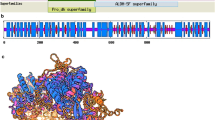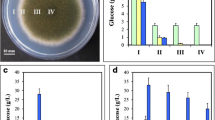Abstract
Transfer of exponentially growing colonies ofSchizophyllum commune to nitrogen-deficient media for 6–60 h resulted in increased general proteolytic activity and decreased extractable protein when compared with controls. A concomitant increase in free radiolabeled leucine was detected in nitrogen-deprived colonies. Radiolabel was found in new surface hyphae following transfer of previously labeled colonies to media containing no label. The concentration of label present in the new growth indicates that this label is likely to have originated from proteolytic release of label from proteins in the older, central portions of the colony. The release of substantial amounts of label into the growth medium suggests that an extra-mycelial pathway may account, at least in part, for translocation of amino acids released by proteolysis.
Similar content being viewed by others
Literature Cited
Allerman K, Olsen J, Smith JE (1983) Asexual differentiation in the fungi. In: Smith JE (ed) Fungal differentiation. New York: Marcel Dekker, pp 419–448
Bond JS, Butler PE (1987) Intracellular proteases. Annu Rev Biochem 56:333–364
Bradford MM (1976) A rapid and sensitive method for the quantification of microgram quantities of protein utilizing the principle of protein-dye binding. Anal Biochem 72:248–254
Chiu FC, Goldman JE (1984) Synthesis and turnover of cytoskeletal proteins in cultured astrocytes. J Neurochem 42:166–174
Cohen BL, Drucker H (1977) Regulation of exocellular protease inNeurospora crassa: induction and repression under conditions of nitrogen starvation. Arch Biochem Biophys 182:601–613
Cooke R (1983) Morphogenesis of sclerotia. In: Smith JE (ed) Fungal differentiation. New York: Marcel Dekker, pp 397–418
Fenn P, Kirk TK (1981) Relationship of nitrogen to the onset and suppression of ligninolytic activity and secondary metabolism inPhaenerochaete chrysosporium. Arch Microbiol 130:59–65
Garraway MO, Evans RC (1984) Fungal nutrition and physiology. New York: Wiley
Lilly WW, Higgins SM, Wallweber GJ (1990) Electrophoretic detection of multiple proteases fromSchizophyllum commune. Mycologia 82:505–508
Lilly WW, Higgins SM, Wallweber GJ (1990) Uptake and translocation of 2-aminoisobutyric acid bySchizophyllum commune. Exp Mycol 14:169–177
Loesch EH (1980) Effects of stress on hydrolases in the vegetative hyphase ofSchizophyllum commune. Masters thesis, Univ. of Minn., St. Paul
Lopez S, Gancedo JM (1979) Effect of metabolic conditions on protein turnover in yeast. Biochem J 178:769–776
May GD, Lilly WW (1988) A rapid method for extraction of membrane-plate grown fungal cultures. Mycologia 80:247–249
Mayer RJ, Doherty F (1986) Intracellular protein catabolism: state of the art. FEBS Lett 198:181–193
Meinhardt F, Esser K (1983) Genetic aspects of sexual differentiation in fungi. In: Smith JE (ed) Fungal differentiation. New York: Marcel Dekker, pp 537–558
Poole B, Wilbo M (1973) Protein degradation in cultured cells: the effect of fresh medium, fluoride and iodoacetate on the digestion of cellular protein of rat fibroblasts. J Biol Chem 248:6221–6226
Rechsteiner M (1987) Ubiquitin mediated pathways for intracellular proteolysis. Annu Rev Cell Biol 3:1–30
Sessoms DB, Lilly WW (1986) Derepressible proteolytic activity in homokaryotic hyphae ofSchizophyllum commune. Exp Mycol 10:294–300
Watkinson SC (1984) Morphogenesis of theSerpula lacrimans colony in relation to its function in nature. In: Jennings DH, Rayner ADM (eds) The physiology and ecology of the fungal mycelium. Cambridge, England: Cambridge Univ. Press, pp 165–184
Watkinson SC, Davison EM, Bramah J (1981) The effect of nitrogen availability on growth and celluloysis bySerpula lacrimans. New Phytol 89:295–305
Author information
Authors and Affiliations
Rights and permissions
About this article
Cite this article
Lilly, W.W., Wallweber, G.J. & Higgins, S.M. Proteolysis and amino acid recycling during nitrogen deprivation inSchizophyllum commune . Current Microbiology 23, 27–32 (1991). https://doi.org/10.1007/BF02092305
Issue Date:
DOI: https://doi.org/10.1007/BF02092305




